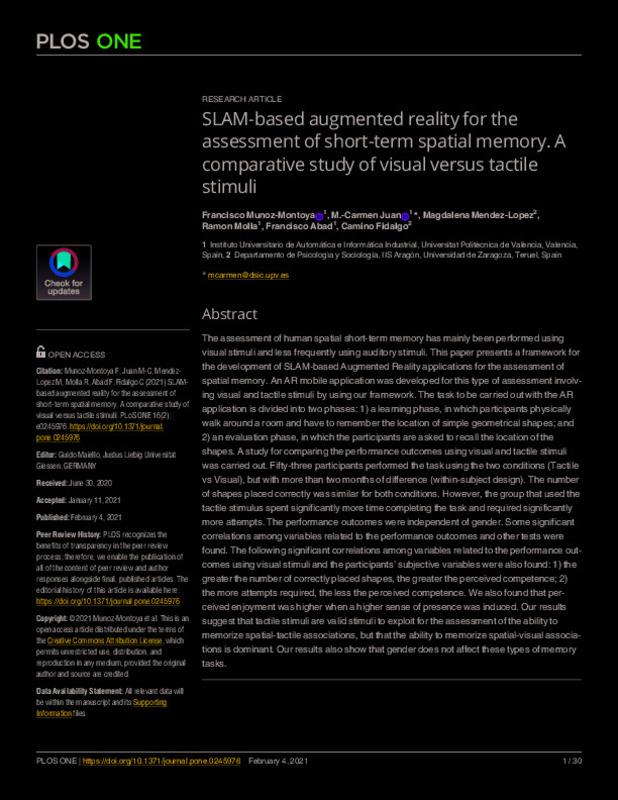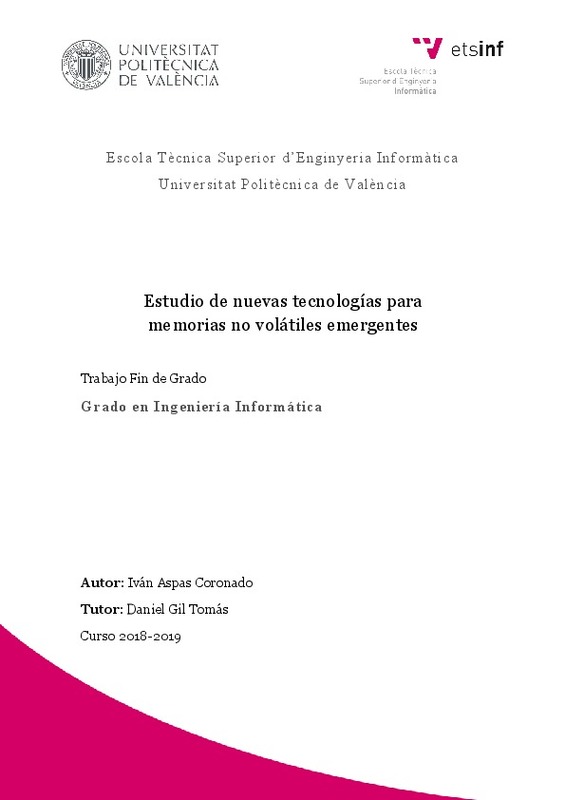JavaScript is disabled for your browser. Some features of this site may not work without it.
Buscar en RiuNet
Listar
Mi cuenta
Estadísticas
Ayuda RiuNet
Admin. UPV
SLAM-based augmented reality for the assessment of short-term spatial memory. A comparative study of visual versus tactile stimuli
Mostrar el registro sencillo del ítem
Ficheros en el ítem
| dc.contributor.author | Muñoz-Montoya, Francisco Miguel
|
es_ES |
| dc.contributor.author | Juan, M.-Carmen
|
es_ES |
| dc.contributor.author | Mendez-Lopez, Magdalena
|
es_ES |
| dc.contributor.author | Mollá Vayá, Ramón Pascual
|
es_ES |
| dc.contributor.author | Abad Cerdá, Francisco José
|
es_ES |
| dc.contributor.author | Fidalgo, Camino
|
es_ES |
| dc.date.accessioned | 2022-10-10T18:07:54Z | |
| dc.date.available | 2022-10-10T18:07:54Z | |
| dc.date.issued | 2021-02-04 | es_ES |
| dc.identifier.issn | 1932-6203 | es_ES |
| dc.identifier.uri | http://hdl.handle.net/10251/187394 | |
| dc.description.abstract | [EN] The assessment of human spatial short-term memory has mainly been performed using visual stimuli and less frequently using auditory stimuli. This paper presents a framework for the development of SLAM-based Augmented Reality applications for the assessment of spatial memory. An AR mobile application was developed for this type of assessment involving visual and tactile stimuli by using our framework. The task to be carried out with the AR application is divided into two phases: 1) a learning phase, in which participants physically walk around a room and have to remember the location of simple geometrical shapes; and 2) an evaluation phase, in which the participants are asked to recall the location of the shapes. A study for comparing the performance outcomes using visual and tactile stimuli was carried out. Fifty-three participants performed the task using the two conditions (Tactile vs Visual), but with more than two months of difference (within-subject design). The number of shapes placed correctly was similar for both conditions. However, the group that used the tactile stimulus spent significantly more time completing the task and required significantly more attempts. The performance outcomes were independent of gender. Some significant correlations among variables related to the performance outcomes and other tests were found. The following significant correlations among variables related to the performance outcomes using visual stimuli and the participants¿ subjective variables were also found: 1) the greater the number of correctly placed shapes, the greater the perceived competence; 2) the more attempts required, the less the perceived competence. We also found that perceived enjoyment was higher when a higher sense of presence was induced. Our results suggest that tactile stimuli are valid stimuli to exploit for the assessment of the ability to memorize spatial-tactile associations, but that the ability to memorize spatial-visual associations is dominant. Our results also show that gender does not affect these types of memory tasks. | es_ES |
| dc.description.sponsorship | This work was funded mainly by FEDER/Ministerio de Ciencia e Innovacion - Agencia Estatal de Investigacion/AR3Senses (TIN2017-87044-R); other support was received from the Generalitat Valenciana/Fondo Social Europeo (ACIF/2019/031); the Gobierno de Aragon (research group S31_20D) and FEDER 2020-2022 "Construyendo Europa desde Aragon". The funders had no role in study design, data collection and analysis, decision to publish, or preparation of the manuscript. | es_ES |
| dc.language | Inglés | es_ES |
| dc.publisher | Public Library of Science | es_ES |
| dc.relation.ispartof | PLoS ONE | es_ES |
| dc.rights | Reconocimiento (by) | es_ES |
| dc.subject | Multidisciplinary | es_ES |
| dc.subject | Computer science | es_ES |
| dc.subject | Psychology | es_ES |
| dc.subject | Augmented reality | es_ES |
| dc.subject | SLAM | es_ES |
| dc.subject | Augmented reality based on SLAM | es_ES |
| dc.subject | Mobile app | es_ES |
| dc.subject | Short-term spatial memory | es_ES |
| dc.subject | Spatial memory | es_ES |
| dc.subject | Memory | es_ES |
| dc.subject | Assessment of spatial memory | es_ES |
| dc.subject | Visual stimuli | es_ES |
| dc.subject | Tactile stimuli | es_ES |
| dc.subject | Sense of sight | es_ES |
| dc.subject | Sense of touch | es_ES |
| dc.subject | Comparative study | es_ES |
| dc.subject | Recall (memory) | es_ES |
| dc.subject.classification | LENGUAJES Y SISTEMAS INFORMATICOS | es_ES |
| dc.title | SLAM-based augmented reality for the assessment of short-term spatial memory. A comparative study of visual versus tactile stimuli | es_ES |
| dc.type | Artículo | es_ES |
| dc.identifier.doi | 10.1371/journal.pone.0245976 | es_ES |
| dc.relation.projectID | info:eu-repo/grantAgreement/AEI/Plan Estatal de Investigación Científica y Técnica y de Innovación 2013-2016/TIN2017-87044-R/ES/REALIDAD AUMENTADA A TRAVES DE VARIOS CANALES SENSORIALES. APLICACION A PROCESOS DE ORIENTACION Y LOCALIZACION ESPACIAL/ | es_ES |
| dc.relation.projectID | info:eu-repo/grantAgreement/GVA//ACIF%2F2019%2F031/ | es_ES |
| dc.relation.projectID | info:eu-repo/grantAgreement/Gobierno de Aragón//S31_20D/ | es_ES |
| dc.rights.accessRights | Abierto | es_ES |
| dc.contributor.affiliation | Universitat Politècnica de València. Departamento de Sistemas Informáticos y Computación - Departament de Sistemes Informàtics i Computació | es_ES |
| dc.description.bibliographicCitation | Muñoz-Montoya, FM.; Juan, M.; Mendez-Lopez, M.; Mollá Vayá, RP.; Abad Cerdá, FJ.; Fidalgo, C. (2021). SLAM-based augmented reality for the assessment of short-term spatial memory. A comparative study of visual versus tactile stimuli. PLoS ONE. 16(2):1-30. https://doi.org/10.1371/journal.pone.0245976 | es_ES |
| dc.description.accrualMethod | S | es_ES |
| dc.relation.publisherversion | https://doi.org/10.1371/journal.pone.0245976 | es_ES |
| dc.description.upvformatpinicio | 1 | es_ES |
| dc.description.upvformatpfin | 30 | es_ES |
| dc.type.version | info:eu-repo/semantics/publishedVersion | es_ES |
| dc.description.volume | 16 | es_ES |
| dc.description.issue | 2 | es_ES |
| dc.identifier.pmid | 33539369 | es_ES |
| dc.identifier.pmcid | PMC7861452 | es_ES |
| dc.relation.pasarela | S\427702 | es_ES |
| dc.contributor.funder | Gobierno de Aragón | es_ES |
| dc.contributor.funder | Generalitat Valenciana | es_ES |
| dc.contributor.funder | AGENCIA ESTATAL DE INVESTIGACION | es_ES |
| dc.contributor.funder | European Regional Development Fund | es_ES |











